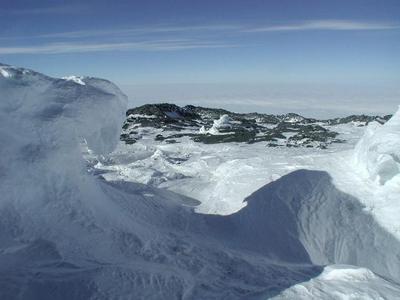11 December, 2001
Weather report: I woke up today sweltering. I fully expected to get out
of my tent to a 60 degree day. I woke up completely out of my sleeping
bag, and warm as toast. The secret is; no wind, sunshine, and getting
used to it. Wind speed: 3 knots. Temperature: negative 11 degrees C (one
of the warmest days the leaders of this party remember during a field
season). We headed up the mountain for radioactive isotope gas collection
and some seismic station upgrading. Beautiful.
The afternoon and evening provided the best experience of the day. The
mapping of ice fumeroles around the circumference of Erebus has become
something of a research priority. It is great fun. The deal is that
volcanoes don't just spit out of one handy opening, like every volcano
model that you've ever seen in a science fair. They emit gases from all
sorts of places around their sides, and the genesis of this heat and gas
is under suspicion. It could be from a young lave flow (1884). It could
be from fissures within the edifice of the mountain itself. The actual
source of heat could be the proximity of the magma chamber, but we are
still learning. So what do you do? You gather data. You map the whole
system of fumeroles spewing their gases and look for a pattern around the
mountain. GPS (see yesterday) is an awesome tool here.
Emily Desmerais straps on a field pack that contains state-of-the-art GPS
hardware, and we begin a planned hike; photographing, taking notes, and
all the while Emily is punching in coordinates that map the field of
volcanic activity exactly. Back to the hut, hooked up to a laptop, and
the mysterious "collapse fields" and ice caves are resolved to a real
map. This is cool.
This also sheds a little light on how science is sometimes done.
Students; look at a textbook description of how the Scientific Method
proceeds. It doesn't always work that way. Sometimes you have to look
for windows of opportunity to gather data. If someone has a bright idea
about degassing from side fissures in magma systems around volcanoes, they
can't just stroll outside and check it out. So we take the availability
at our fingertips and gather the information that we can--hopefully
figuring it out later.
I would say that this little exercise was not without risk. Everywhere we
went, we had to jab around with our ice axes to make sure that we were not
walking over some slight ceiling of an ice cave that might collapse under
weight. It turned out that we were in fact walking over an extensive
honeycomb of heat-generated spaces between ice cover and rock. Safety
first, and cautious advances.
What will be the result of this research? We don't know. What a great
opportunity to get out and explore--recording all the while--to see just
how this whole system works.

Emily Desmerais logs the location of what appears to be an insignificant fumerole. Upon investigation, the opening was a gateway into a vast sub-surface void.

This is an other-worldy place. We learned today to recognize areas of collapse. Fumeroles are separated by areas of domes and pits that indicate heat carving a place for itself just under the surface. Exploration is done with great care.

Dr. Jeff Johnson ascends a fumerole at the end of the day.
Contact the TEA in the field at
.
If you cannot connect through your browser, copy the
TEA's e-mail address in the "To:" line of
your favorite e-mail package.
|
